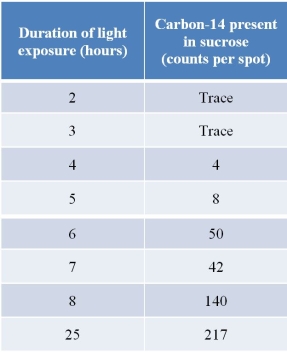Multiple Choice
Refer to the table below showing results of some researchers who exposed wheat plants to 14C-labeled carbon dioxide for various lengths of time in the light before extracting various compounds from leaves.The extracted compounds were separated using paper chromatography, and the amount of radioactivity for each spot on the chromatogram was measured for a specified duration of light exposure.The results for sucrose are shown in the table.  In a control run, during which plants were kept in the dark, no radioactivity was incorporated into sucrose over a 25-hour time period.Which statement about sucrose is supported by these data?
In a control run, during which plants were kept in the dark, no radioactivity was incorporated into sucrose over a 25-hour time period.Which statement about sucrose is supported by these data?
A) A plant can use sucrose as a source of energy during periods of darkness when photosynthesis shuts down.
B) Sucrose is the form of fixed carbon that is transported from photosynthetic tissues to nonphotosynthetic tissues throughout the plant.
C) G3P formed via the Calvin cycle can enter gluconeogenesis to form hexose phosphates and then sucrose in plant leaves.
D) Glucose and fructose are monosaccharides that bond together to form the disaccharide sucrose.
E) Sucrose serves as a source of fixed carbon that can be distributed throughout the plant.
Correct Answer:

Verified
Correct Answer:
Verified
Q32: In addition to driving the synthesis of
Q33: Refer to the figure below. <img src="https://d2lvgg3v3hfg70.cloudfront.net/TB5650/.jpg"
Q34: Researchers developing herbicidal chemical agents tested one,
Q35: In the following equation: 12 H<sub>2</sub>O <font
Q36: The precise moment when light energy is
Q38: Refer to the figure below. <img src="https://d2lvgg3v3hfg70.cloudfront.net/TB5650/.jpg"
Q39: Which statement about the light-independent reactions of
Q40: Water molecules labeled with <sup>18</sup>O were added
Q41: The first enzyme in C<sub>4</sub> carbon fixation
Q42: Some plants have the capacity to carry